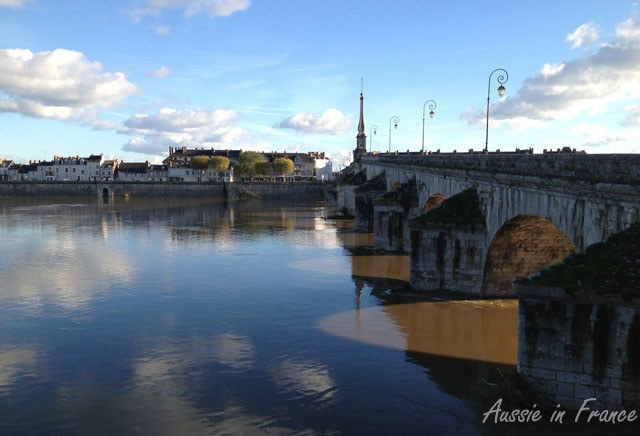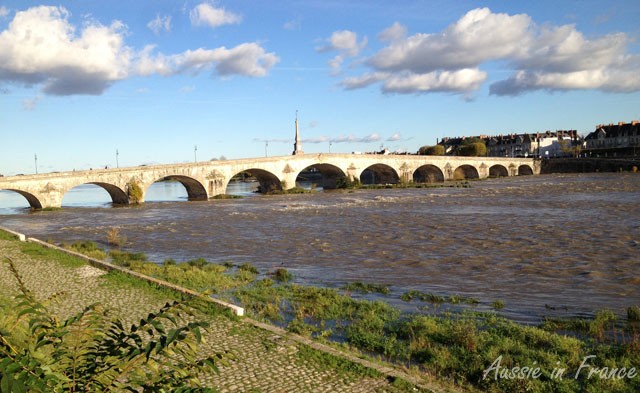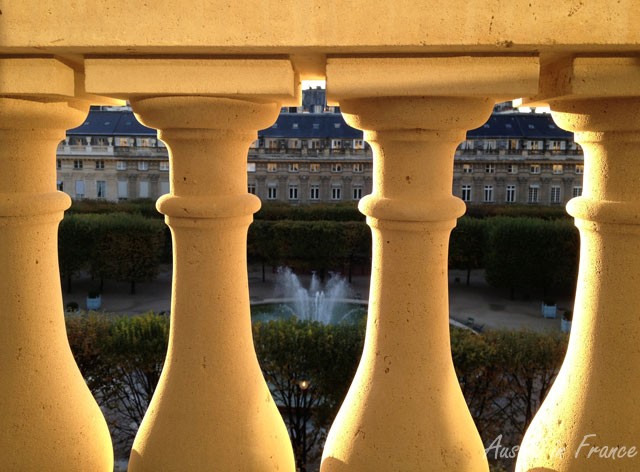This winter we’ll be spending quite a lot of time in Blois. This photo was taken from the Mail Saint Jean riverside road looking towards Vienne with Pont Gabriel on the right. The second photo was taken downstream of the same bridge. The river as suddenly picked up speed.
All posts by Rosemary Kneipp
Friday’s French – capital soleil
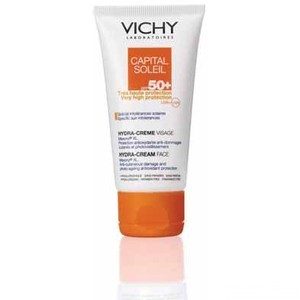 It’s interesting that such a wonderful expression should exist in French and not in English, or at least in Australian English where it would be very useful, given all the sun there compared to what we get in France (it’s a very rainy day today).
It’s interesting that such a wonderful expression should exist in French and not in English, or at least in Australian English where it would be very useful, given all the sun there compared to what we get in France (it’s a very rainy day today).
Your capital soleil is the amount of sun that your body can be exposed to during your lifetime without causing something disastrous like skin cancer. It’s used very widely in advertising for sunscreens in France. Vichy even has a brand called Capital Soleil.
When I’m translating for cosmetic brands, I usually have to rewrite the sentence completely:
Chaque individu dispose d’un capital soleil déterminé à la naissance becomes “Each person can only absorb so much ultraviolet radiation during their lifetime without developing cancer”, for example.
Close in meaning is capital santé which is sort of health and fitness combined. Surprisingly, there is no word for “fitness” in French so salle de fitness and centre de fitness are used.
Yet the French go on fitness kicks as much as anyone else. Maybe the idea could be expressed using forme. J’ai retrouvé la forme means that I got back in shape or got fit again and il a la forme means he’s very fit (well, in the physical sense anyway – it can also mean “he’s in great form”).
So back to capital. Here are some other examples of capital in French where we wouldn’t use “capital” in English (examples from the Robert-Collins dictionary which, if you’re going to use a bilingual dictionary, is probably the best because Harraps has become outdated and the others are pitiful):
le capital de connaissances acquises à l’école = the stock or fund of knowledge acquired at school
la connaissance d’une langue constitue un capital appréciable = knowing a language is a major asset
le capital artistique d’une région = the artistic wealth or resources of a region
elle a su bâtir un capital confiance = she managed to win everybody’s trust
Capital is used in the financial sense of course and we have all sorts of lovely expressions there as well, sometimes using “capital” and sometimes not:
capital circulant = working capital, circulating capital
capital décès = death benefit
capital d’exploitation = working capital
capitaux fébriles = hot money (I love that one!)
capital initial = start-up money
capitaux propres = equity capital (where propre = own and not clean! “Dirty money” is argent noir or sale)
capital social = share capital
Any more suggestions?
Rethinking our projects in the Loire
I was very encouraged by all the sympathetic comments on the post I wrote a couple of weeks ago called War declared by next-door neighbours. Thank you for your support. I have to confess that I have been depressed ever since because it looked like we might have to give up our gîte project altogether. It’s hard enough to change our lifestyle completely – moving from the Palais Royal in the centre of Paris to a 400-year old house in the Loire Valley, where you can’t do anything without a car – without having to rethink our plans for the last two years, even though we really love the house and the area.
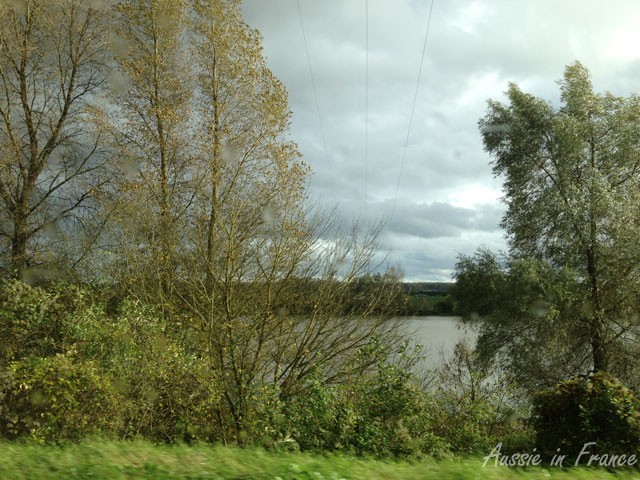
However, yesterday, we invited Mr and Mrs Previous Owners for tea and told them all about it. They agreed that we won’t get anywhere by approaching the neighbours – it could just make matters worse.
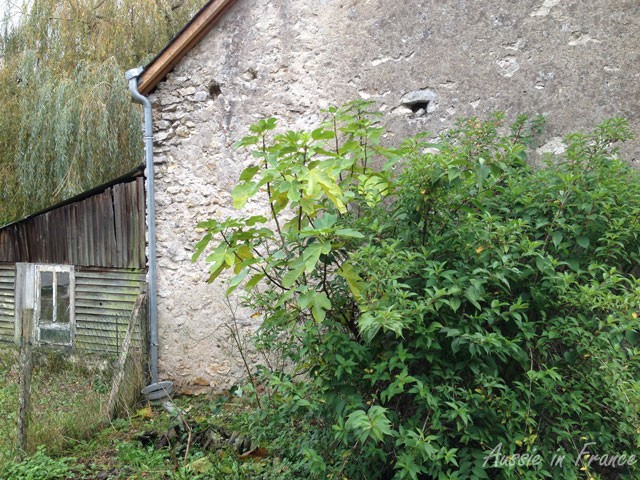
They suggested that we might be able to get the poultry house (or whatever you call it) taken down since it’s built up against the wall of our barn. But that would just leave us open to all sorts of retaliation, I would imagine, particularly with respect to our future guests.
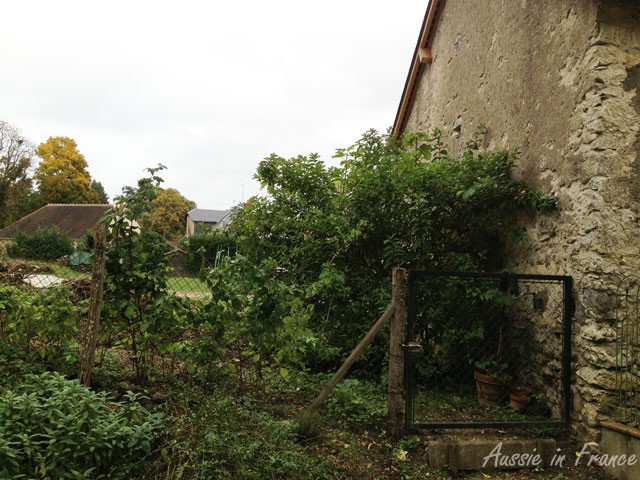
But later, when we were talking about his new vegetable patch, Mr Previous Owner asked Why don’t you use your vegetable patch for the gîte garden? I had suggested this to Jean Michel originally but he said it wasn’t a good idea because the ground is sloping and we forgot all about it.
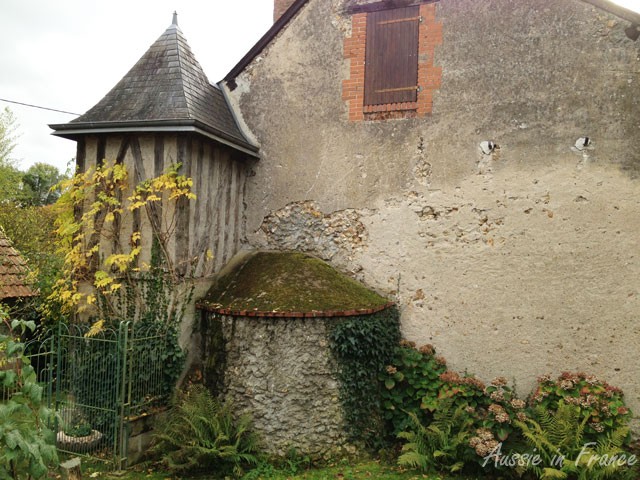
We talked about it again later and it might well be the solution. The vegetable patch is on the other side of the barn, as you can see in the photo, which means that even though you can still hear the goose from time to time, there wouldn’t be the problem of the smell in summer. We’d put up a wall to make the gîte completely separate from the neighbours.
There would be a few steps up from the back door of the gîte to the garden, but I don’t think that’s a problem, do you?
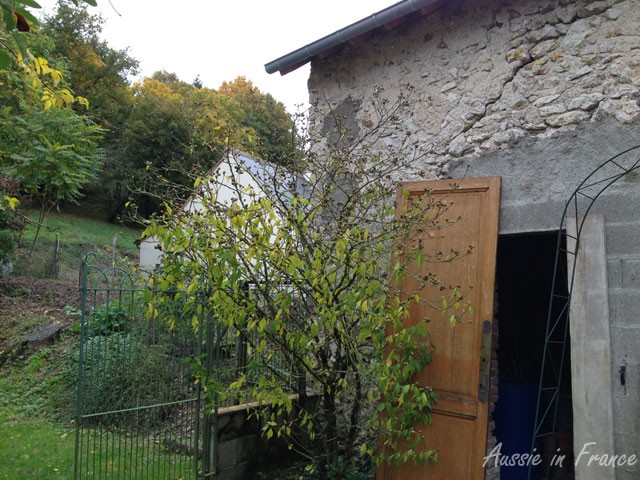
It would mean that the little house could still be used to provide a two-car garage and we could even have a vegetable patch next to the poultry yard if we still want one.
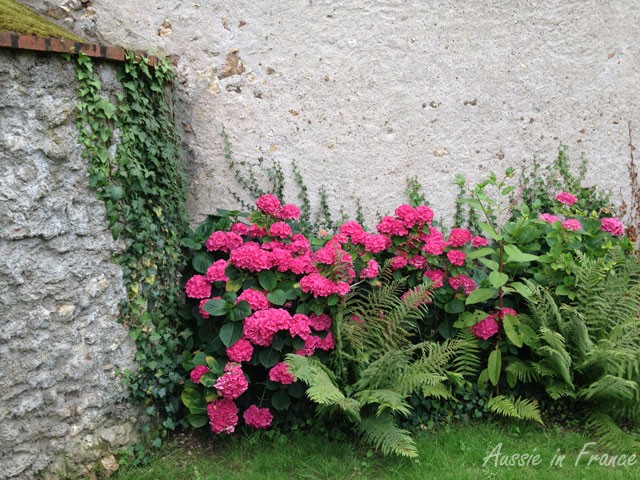
It’s probably even a better solution than the original one of having the garden in front of the gîte, because guests would have the lovely view of our tower, bread oven and hydrangeas in the summer.
Today, my depression has lifted.
Wednesday’s Blogger Round-Up: Michelin star restaurants – Chrysanthemums in France – All Saints’ Day
This week, The Good Life France, appearing for the first time in my Wednesday’s Blogger Round-Up, explains the origin of the Michel star award to French restaurants, while two Aussies, whom I’ve often quoted here – Wendy Hollands from Le Franco Phoney and Phoebe from Lou Messugo – share their experience of the chrysanthemum tradition in France. Enjoy!
What does Michelin star restaurant mean?
Written by The Good Life France, an independent on-line magazine about France and all things French, covering all aspects of daily life including healthcare, finance, utilities, education, property and a whole lot more.
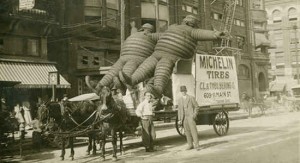 Most people are aware of Michelin the tyre company and their famous logo Michelin Man the roly-poly tyre man – or Monsieur Bibendum which is his real name. His image is known the world over and he does an excellent job of promoting the company’s tyres.
Most people are aware of Michelin the tyre company and their famous logo Michelin Man the roly-poly tyre man – or Monsieur Bibendum which is his real name. His image is known the world over and he does an excellent job of promoting the company’s tyres.
Michelin is also famous for ranking restaurants – achieving a Michelin star status is like the Holy Grail for chefs – to have one is to be acknowledged as amongst the elite, to have reached the pinnacle of one’s profession. For customers it is in an indication that the restaurant that has been awarded a Michelin star status will almost certainly guarantee an epicurean experience, a high quality meal, a great ambience. Read more
Chrysanthemums and Death in France
by Wendy Hollands from Le Franco Phoney, an Australian who writes about all things French in La Clusaz, Annecy and Haute Savoie as seen by an outsider
 There’s a reason that faux pas is a French phrase. As a non-French person, I’m constantly making mistakes with both the language and the culture. I reckon they invented it for foreigners.
There’s a reason that faux pas is a French phrase. As a non-French person, I’m constantly making mistakes with both the language and the culture. I reckon they invented it for foreigners.
As mortifying as it can be to mix up ‘chiot‘ (puppy) and ‘chiottes‘ (toilets), or ‘canard‘ (duck) and ‘connard‘ (idiot), failing at French cultural etiquette can be equally as bad.
For example, a French breakfast with friends is no fast meal. Expect to spend hours absorbing your food — dunk your croissant into your bowl (yes, bowl) of coffee and break off a bit more baguette while you all catch up. That butter, jam and Nutella is on the table for the baguette, not the croissant. Do not apply these products to the croissant! They might not say anything, but they’ll think you’re weird: croissants are eaten without spreads in France. Read more
All Saints Day – Flowers and French traditions
by Phoebe from Lou Messugo, a traveller, francophile, expat, mum and foodie now living in Roquefort les Pins where she runs a gîte after many years of travelling and living in Asia, Eastern Europe and Australia
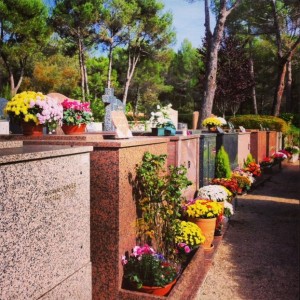 This weekend has been all about Toussaint, a Catholic holiday honoring all Saints. It is a time when French pay respect to their deceased relatives. All Saints’ Day, the 1st of November, sees families gathering to visit cemeteries to clean and decorate tombs. And they decorate them mainly with chrysanthemums.
This weekend has been all about Toussaint, a Catholic holiday honoring all Saints. It is a time when French pay respect to their deceased relatives. All Saints’ Day, the 1st of November, sees families gathering to visit cemeteries to clean and decorate tombs. And they decorate them mainly with chrysanthemums.
The tradition of using chrysanthemums is a relatively recent one, dating from 1919 when the then President, Raymond Poincaré, declared that all war memorials should be decorated with floral tributes. As one of the rare flowers still in bloom in November it became the flower of choice for cemeteries, with hundreds of thousands of widows laying blooms at their fallen husbands’ memorials. Read more
Douceur and Le Coup de Fourchette in Blois – two new places to try!
It’s a rainy Sunday afternoon and we’ve finally taken the time to collect our Blésois passes so we’ll have free entry to Blois Royal Castle and the Magic Museum plus lots of other places. The pass will also give our friends a reduction if we’re with them. “So, where do we go for afternoon tea?” says Jean Michel. A Facebook friend from the Loire Connexion has told me about Douce Heure (literally Sweet Time and a pun on Douceur meaning something sweet to eat) on the Loire side of Place Louis XII, so we decide to go there.
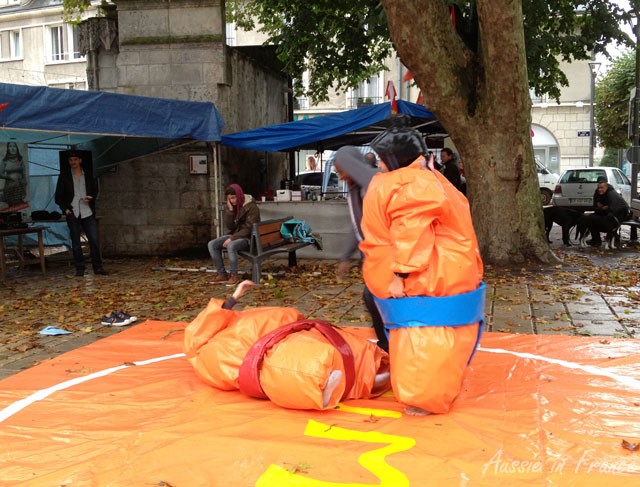
As we’re coming down the steps from the castle, a child says, “Look – a duck!” but in fact it’s a mosaic swan which I had never noticed before. We go past some pseudo sumos that are part of a Community Party festival of some sort. We watch for a while. They are exceedingly funny. Now why didn’t I take a video?
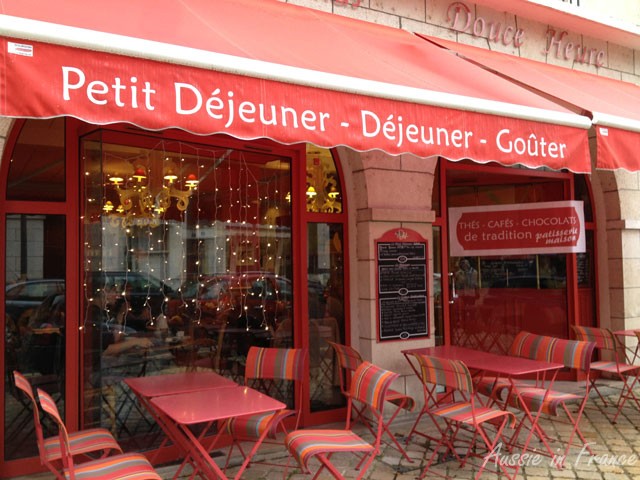
We arrive at Douce Heure and regret that we can’t use the attractive lollipop terrace but we go inside and it feels very inviting and cosy after the awful weather outside.
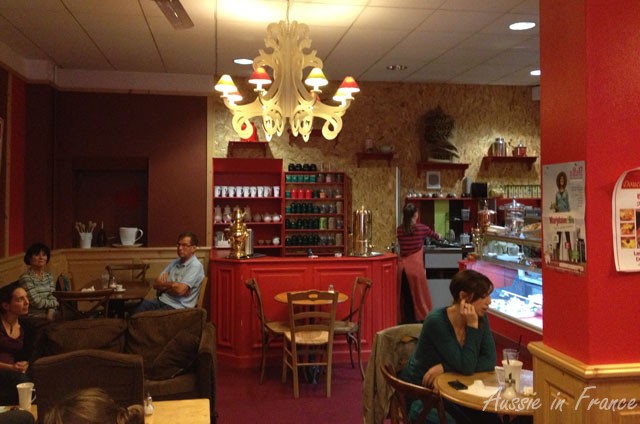
There is a large choice of tea, coffee and hot chocolate. We choose a cake each – a candied fruit cheese cake and a fruit tart – and are halfway through eating them when it occurs to me to take a photo!
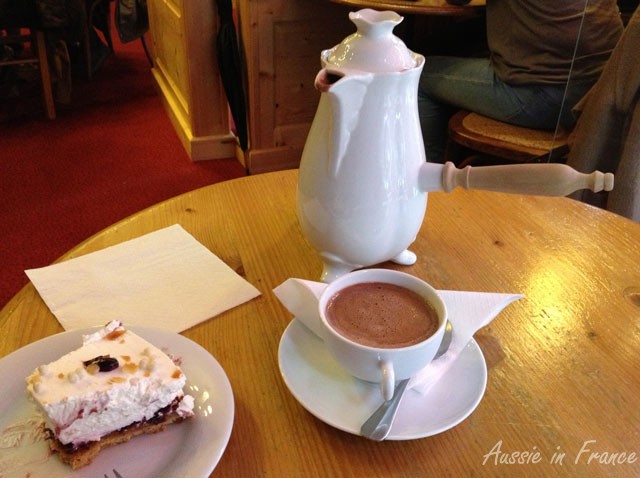
We both order hot chocolate. It comes in a special chocolate pot and is thick and creamy. We have two very decadent cups each! That solves the problem of what to have for dinner tonight – nothing!
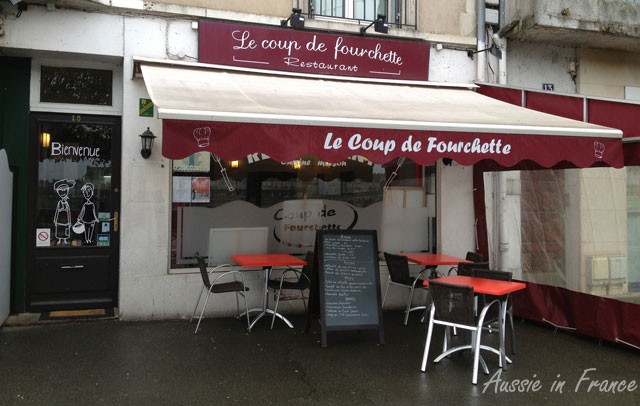
It’s a little more than a week later and we’re back in Blois with nothing in the fridge for lunch. It’s raining again. “Let’s try that restaurant our last guests suggested,” I say. “The one near the market on the river side.” I phone Le Coup de Fourchette to make sure there’s a table.
We park in the underground parking lot so we don’t get too wet going to the restaurant. Its red, white and black décor is very inviting and there is a large Bienvenue on the door. Inside there is a perroquet (parrot – why parrot?) coat stand. What an excellent idea. I hate having to sit with my coat draped on the back of my chair.
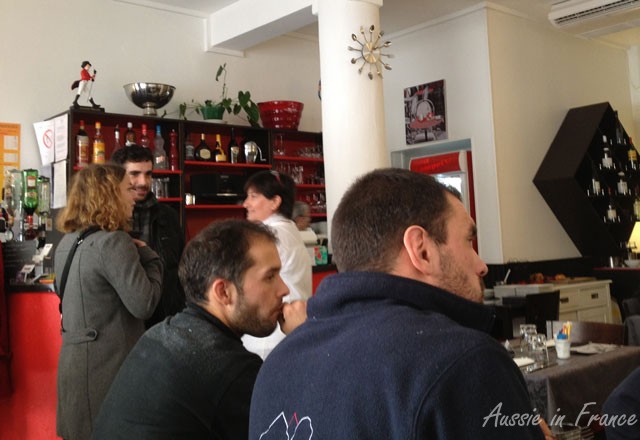
The welcome is warm and friendly and we are shown to our table. For the moment, the dining room is fairly empty but it soon fills up with locals – mainly men – with big appetites as befits a restaurant whose name means “a hearty appetite”.
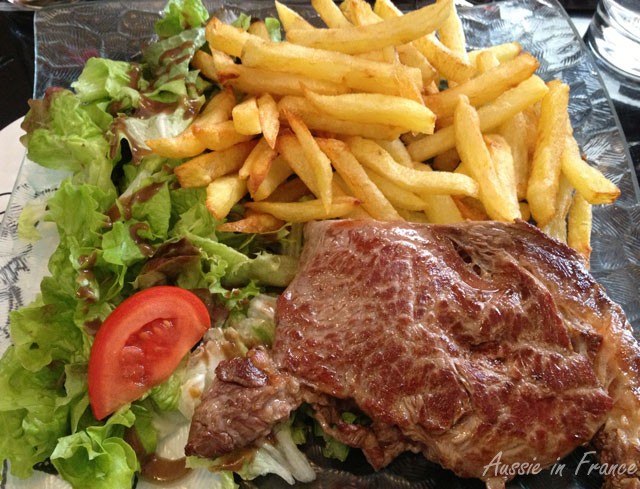
The waitress explains the menu and shows us the blackboard with the day’s specials. Prices start at about 10 or 11 euro for starter plus main course or main course plus dessert. We choose an entrecôte + French fries + green salad + dessert (café gourmand) each and a ½ bottle of local Touraine Vieilles Vignes red wine for a total of 39 euro.
The French fries are excellent and the meat is tasty. We have three mini-desserts with our café gourmand.
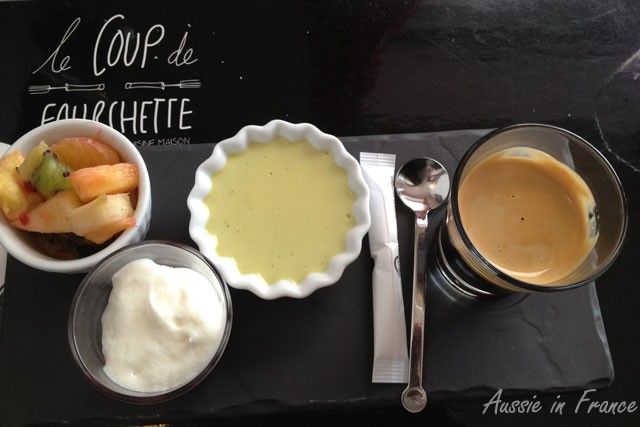
This is not a gastronomical restaurant. It’s a local eatery, frequented by locals all year round and savvy tourists during the summer, attracted by the terrace. It’s been open for just a little over a year and has already earned the Trip Advisor Certificate of Excellence, ranked 2 out of 103 restaurants in Blois, just after Les Planches which is next on our list!
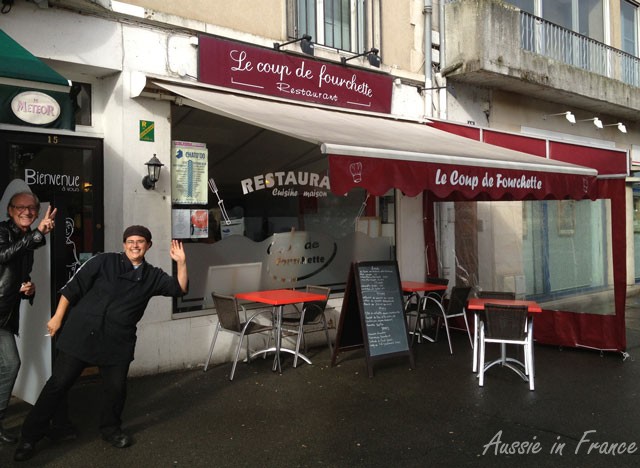
The service and atmosphere are friendly, the food is simple but good and hearty. The servings are copious. Excellent value for money. We’ll definitely be back!
Douce Heure, place Louis XII, 41000 Blois. Open all year round. 10 am to 7 pm. Closed Mondays. Le Coup de Fourchette, 15 Quai de la Saussaye, 41000 BLOIS, 02 54 55 00 24. Open Monday to Wednesday, lunchtime only and Thursday to Saturday, lunchtime and evening.Monday’s Photo of the Week – Double Rainbow
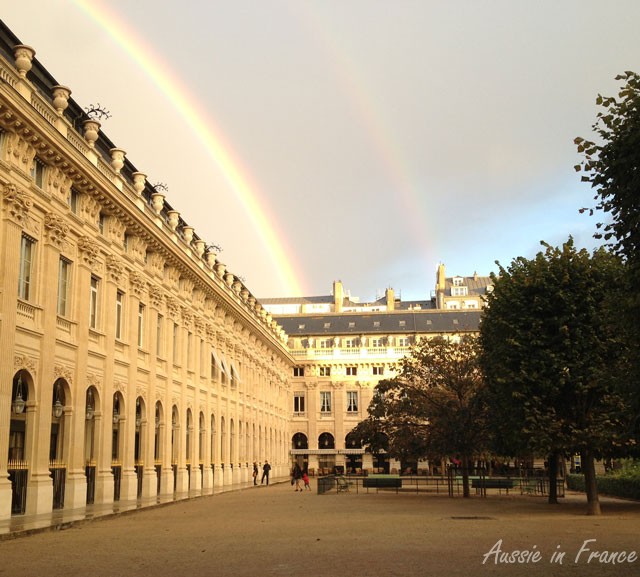 This photo owes its existence to Australian photographer Wendy Smith who is currently living in France. We were walking along chatting in the Palais Royal after a sudden shower chased us off the terrace of the Café Nemours. Suddenly, Wendy said, “the light – it’s really amazing! look over there!”. I rushed to the fence and slipped my iPhone through. It was not until I saw the photo on Instagram that I realised there were TWO rainbows!
This photo owes its existence to Australian photographer Wendy Smith who is currently living in France. We were walking along chatting in the Palais Royal after a sudden shower chased us off the terrace of the Café Nemours. Suddenly, Wendy said, “the light – it’s really amazing! look over there!”. I rushed to the fence and slipped my iPhone through. It was not until I saw the photo on Instagram that I realised there were TWO rainbows!
Friday’s French – epouvantable epouvantail
It should really be épouvantable épouvantail but WordPress (the blog template I use) doesn’t deal with accents in titles well, so I try to avoid them.
An épouvantail (épouvantail à oiseaux, in its full form) is a scarecrow, from épouvante which means terror, from the Latin expavens, entis, fear which also gave the Italian spaventare. I can’t think of any related English words, which is most unusual with all the French-based borrowings due to the Norman invasion.
The adjective from épouvante is épouvantable meaning dreadful or appalling. Quelle histoire épouvantable means what a shocking/appalling story.
And, of course, a film d’épouvante is a horror film and a roman d’épouvante a horror story.
I thought a post on épouvante was sort of appropriate considering that yesterday was Halloween! And if you’d like to know more about Halloween in France, you might like to click on the post I wrote last year.
Death Hunt with THATLou
It’s almost Halloween. I’m dressed in black from head to toe as instructed and standing in line to buy my entrance ticket to the museum in order to participate in a Treasure Hunt at the Louvre by THATLou. “Hi”, says a voice behind me. I turn to see Sylvia from Finding Noon in this stunning purple witch’s hat and skull necklace.
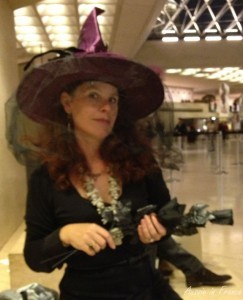
We join Daisy de Plume, who’s running the show, at the meeting point and the other participants soon arrive. I am introduced to my team mates: Elodie from the Paris tourist office and Amanda and her 17-year-old son Eric. They’ve already done a hunt before, I’m pleased to hear, while Elodie and I are newcomers to the game.
At 7 pm sharp, Daisy starts explaining the rules and we’re given our clue sheet. We have one and a half hours to find as many treasures as possible out of a total of 32. There are points for finding each treasure (10 to 80 depending on the difficulty) and bonus points buried in each explanation. Photographs of the team in front of the treasure will prove it has been found.
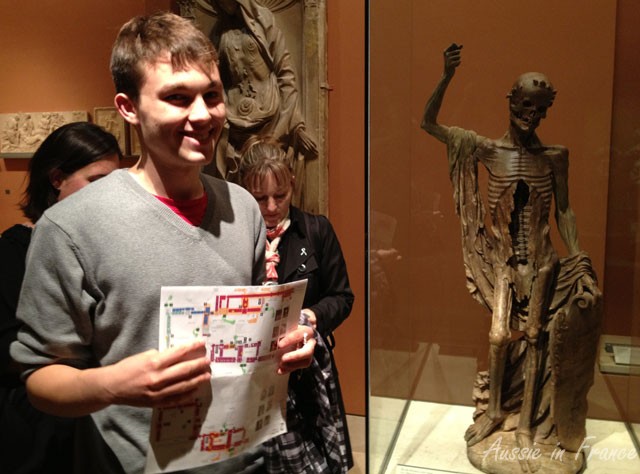
Each member of the team of three to four people (there are seven teams tonight) is assigned a role. I’m the photographer (though sadly, my iPhone lets me down and a lot of the photos turn out a little blurred), Eric is the map-reader, Amanda the main clue reader and Elodie is the able assistant. In addition to taking photographs, I have to keep my eyes peeled for the treasures.
The first thing is to devise a search strategy by assigning each treasure to an area on the museum map highlighted by Daisy to indicate the sections of the Louvre involved in the hunt. It’s a very large museum so we don’t want to be rushing from one end to the other in just any old order, particularly as we’re not allowed to run or split up during the hunt.
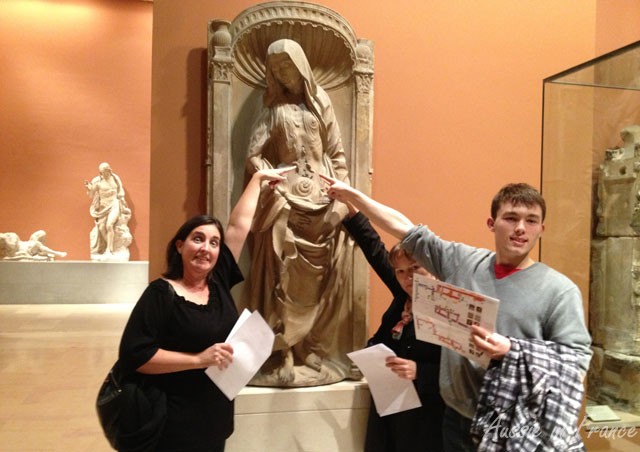
Eric is champing at the bit, eager to find our first treasure. We start in the French mediaeval sculpture section with Death St Innocent* where team members are to be photographed pointing to worms. There are also bonus points for finding how many unicorns there are in the room. Amanda spies one on a bas relief. “Devious”, she says.
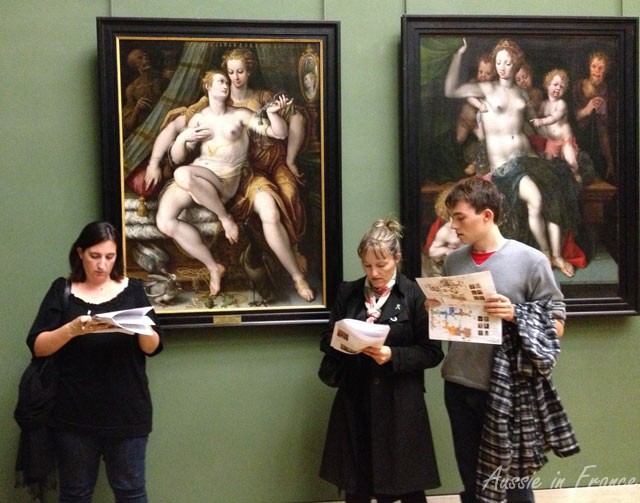
Once we have found all the treasures in one section, we move onto the next. In front of a painting of Christ resurrected, we’re instructed to represent the hand positions of the figures behind us. Elodie cleverly winds a shawl around her in lieu of a wall.
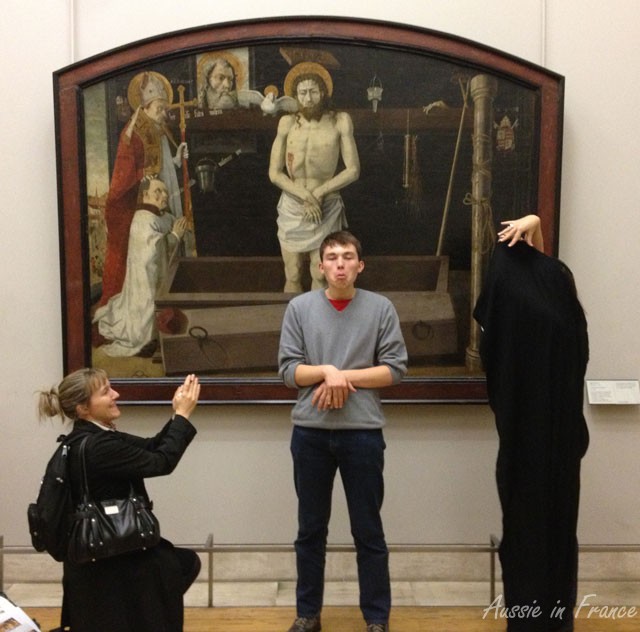
As time marches on, the pace picks up. One section turns out to be unexpectedly shut but thanks to Amanda’s determination, we find the treasure anyway. The team pauses in front of Ingres’ Grande Odalisque to win 10 bonus points by looking over their shoulders.
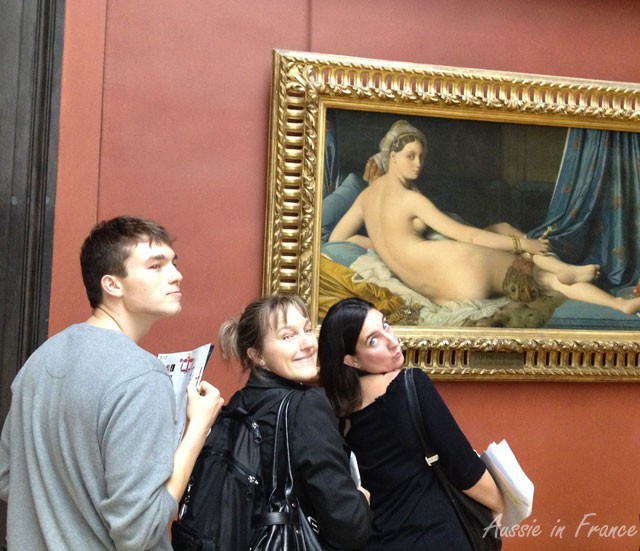
Only once do we come across another team, towards the end of the hunt. Time is running out, we only have ten minutes to get back to the starting point or we’ll be docked two points for every one minute late! We haven’t found all the treasures but Daisy has already told us that it’s impossible to do so.
As we hurry back, we make up a limerick** to go with the Raft of the Medusa – there’s a separate prize for the winning rhyme. We make it just in time. We sit down to tally up our points and catch our breath. Daisy was certainly right to tell us to wear comfortable shoes!
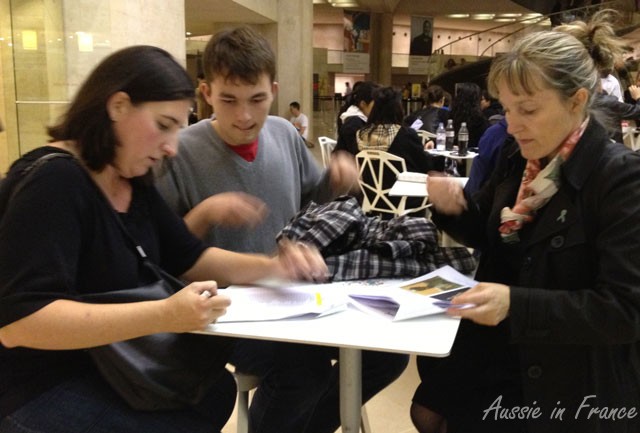
Then we all head to L’Imprimerie for a drink and dinner. We’re given the answer sheet so we can tally up our bonus points. There’s an extra 50 points and a separate prize for inventing a team name***. We choose the Skeltering Skeletons. Everyone votes for a winner and WITCHLou, which I have to admit is better than ours, takes the prize.
By the time our meal arrives, Daisy has finalised the scores. The Skeltering Skeletons win with 1150 points out of a total of 2000, more than 400 ahead of the runners-up. We all cheer and share our winning coasters of paintings in the Louvre. The other teams receive their prizes****. As it’s a little noisy, we can’t read out our limericks but they will be posted on THATLou’s blog so we can vote for the winner.
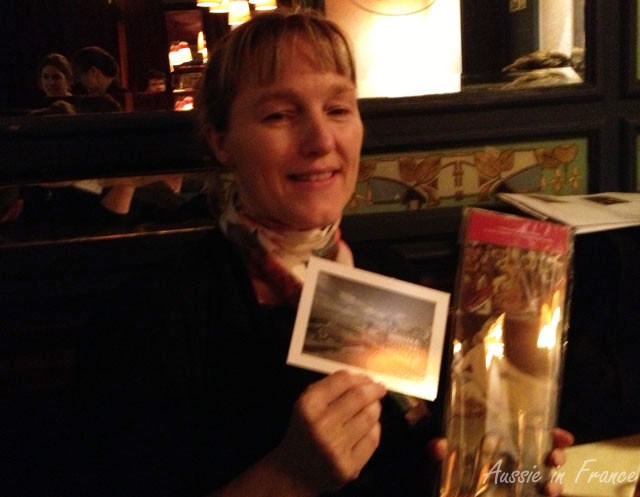
We all agree we have had a wonderful time and seen parts of the Louvre and art works we would never have known about otherwise. Our attention to detail has been sharpened. I attribute our win to the excellent organisation and friendly cooperation of our team and the fact that we read some of Daisy’s posts beforehand. Having an enthusiastic teenager certainly helps as well!
Elodie says she’s going back another day to find the other treasures on the list! I might just join her.
* EXAMPLE OF CLUES – TREASURE 1 DEATH St INNOCENT (La Mort St Innocent) Alabaster, H 1.20m x W .55m x D .27m – from Paris’s Cemetery of Innocents 16th Century French Sculpture (end of Middle Ages) The plaque at Death’s foot reads “There is not a single being alive, however cunning and strong in resistance, whom I will not slay with my dagger, & give to the Worms as their Pittance!” Quick take a whopping thirty points for a photo of your team pointing to these worms (and just look at what they’re doing — Talk about appropriate for this gruesomely ghoulish death hunt!). So our friend Death was originally kept in the Cimitière des Innocents (CDI), which was found smack dab in the center of Paris – abutting the market place of Les Halles. The CDI accepted its first denizens in the 12th Century, as a perfectly orderly graveyard, with a space per individual. But as the city grew, the small swath of CDI (just 130 meters by 65) did not. When space ran out mass burials began to be conducted – up to 1500 dead could be buried in one pit before a new one was dug. Just think about the stench as you’re marketing right next to this grisly pit of death. Horrible. No one moved CDI from the center of town (thirty points for why this is) until Louis XVI passed an edict in 1780 that no more burials should take place. Six years later Mr Skull and Bones here was moved first to St Gervais then to Notre Dame, where he’d be unveiled with his ominous (now missing) dagger only one day a year. Which was? Oh boy, you get another ten points for the correct answer to that! And congrats on your last-minute Louvre prep! POINTS: 80 ** Our limerick Poseidon the god of the sea Rarely took time for a pee, but He pulled down his trunks Screamed “you are all skunks” And did it before all who could see ***Team names: The Skeltering Skeletons WITCHLou = Witches in the Chateau du Louvre Tri’Eiffel Insane Catwomen in the Louvre Cape Coders Dead Funky Unicorns Winning Witches ****Prizes: 1st place = coasters because you deserve a drink and PCs to write home 2nd place = Game of cards to try another game 3rd = Louvre rulers to measure their mediocrity 4th = Mona Lisa Nail Files to buff up on their Louvre finds 5th = little toy cameras with animals, because they should look at animals not art 6th = bookmarks to read up on the Louvre 7th = stickers of the Louvre’s greatest hits to stick to their memory and chocolate coins to bet on another gameWednesday’s Blogger Round-up: Beaugrenelle, the new shopping centre – Dance Macabre – Rue d’Aligre
This Wednesday, Mary Kay from Out and About in Paris takes us to the newest shopping centre in Paris, Beaugrenelle, which even has a Marks & Sparks; Daisy de Plume from THATlou Treasure Hunt at the Louvre whom I will be joining on the evening of October 30 for her Death Hunt, introduces us to the Dance Macabre; while Genie from Paris and Beyond, who has a photo blog about Paris, takes us to the famous Rue d’Aligre. Enjoy!
Beaugrenelle Paris, the newest shopping center in Paris with FREE shuttle boat service from the Eiffel Tower!
by Mary Kay from Out and About in Paris, an American by birth, Swiss by marriage, resident of Paris with a Navigo Pass for the metro that she feels compelled to use
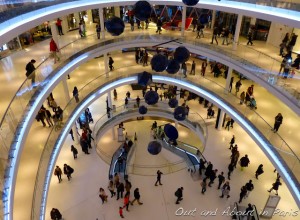 My neighborhood isn’t trendy like the Marais, exclusive like Saint-Germain-des-Prés or charming like Montmartre. It’s a residential area that attracts families who need an extra bedroom rather than hipsters who want to be close to the newest, latest, hottest spot in town. But thanks to the opening of Beaugrenelle Paris, my part of town is on the “must-see” list of Parisians this week.
My neighborhood isn’t trendy like the Marais, exclusive like Saint-Germain-des-Prés or charming like Montmartre. It’s a residential area that attracts families who need an extra bedroom rather than hipsters who want to be close to the newest, latest, hottest spot in town. But thanks to the opening of Beaugrenelle Paris, my part of town is on the “must-see” list of Parisians this week.
For the first time since I’ve lived here, I walked out the front door of our apartment, strolled along the Seine, crossed the Pont de Grenelle and had easy access to stores like Guerlain, Baccarat, Michael Kors, Sandro, H&M, Zara and Desigual. I didn’t have to hop on a bus or fight the crowds in the metro. When it started to rain, I didn’t have to worry that I had forgotten my umbrella (again!) because I was safely inside the newest shopping center in Paris. Read more
Trilogy of Death – Part II
by native New Yorker Daisy de Plume, who has lived in Paris for nearly a decade and created THATLou to share her passion for art and her unique approach toward making the museum experience fun and accessible to all.
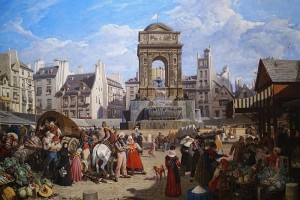 So yesterday we spent a sunny Sunday pondering the dead at the Cimitière des Innocents (CDI), once Paris’s largest and oldest graveyard smack dab in the middle of town (where the Renaissance Fontaine des Nymphs, aka Fontaine des Innocents** currently is, near the RER Les Halles station). We had just touched on how when space ran out, mass graves of 1500 cadavers per pit were filled, before they were closed off and a new one of equal size was dug. But we haven’t yet considered the business of death. Read more
So yesterday we spent a sunny Sunday pondering the dead at the Cimitière des Innocents (CDI), once Paris’s largest and oldest graveyard smack dab in the middle of town (where the Renaissance Fontaine des Nymphs, aka Fontaine des Innocents** currently is, near the RER Les Halles station). We had just touched on how when space ran out, mass graves of 1500 cadavers per pit were filled, before they were closed off and a new one of equal size was dug. But we haven’t yet considered the business of death. Read more
Rue d’Aligre – un Café
by Genie from Paris and Beyond, who lives in Mobile and has loved Paris, its people, its architecture and all of France since she was eight years old. She has a photo blog about Paris and occasionally other places in the world.
Taken on a busy market day (Marché d’Aligre), there is scant room for café table and chairs.
Still, the pastries and a coffee (or thé) can be enjoyed as the market vendors shout out the quality of their wares.
One thinks that the price of the coffee and pastry is small for this front row theatre seat.
Click here to see the photo which I haven’t reproduced as a small photo would never do justice to the original.

